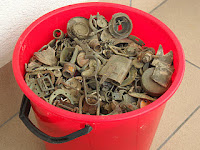8.5: Selling 'Scrap Metal'
 |
| A typical scrap bucket, what unrecognised archaeological evidence is lost here? |
Other artefact hunters place in the 'scrap bucket' all items not wanted for their collection, regardless of age or nature, and regardless of whether they know what it is or not. Each metal object on a site however reached it somehow, and is a potential source of information on what happened on the site. A scatter of shapeless lead fragments is the result of some activity. Plotting them, collecting and analysing them may reveal a pattern about past activity, but most artefact hunters simply throw them away and sell for melting down as scrap (or even themselves melt them into fishing weights for sale). Other items might be in the scrap bucket because the artefact hunter simply did not know what it was, and was unconcerned to think harder about it or research it.
 |
| There are keys in private artefact collections, and how many lock components? If you don't know what you are looking at, you cannot recognise it. |
This is of course totally irresponsible behaviour and simply damages sites and then compounds it by destroying evidence. An artefact hunter exploiting any site should be prepared to take on the responsibility to collect and archive material with all the contextual data, the significance of which is not always apparent at first, for later study. Care should always be taken not to discard archaeological evidence because it was unrecognised as such.
 Tamara Kroftova comments:
Tamara Kroftova comments:"Once again, the ignorance and lack of education orf artefact hunters is leading to the removal and loss of - potentially - enormous amounts of evidence from the archaeological record. It should be the case that objects that are not recognised by the artefact hunter are retained for further study, but the majority are focused on immediate collectability and simply discard the rest. Ignorance is irresponsibility and leads to destruction."



Comments
Post a Comment